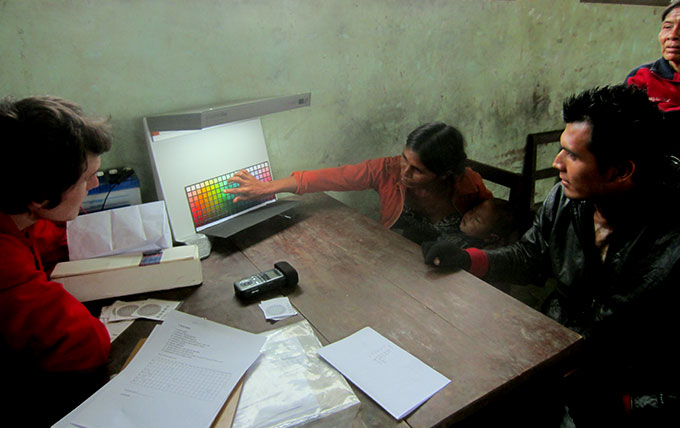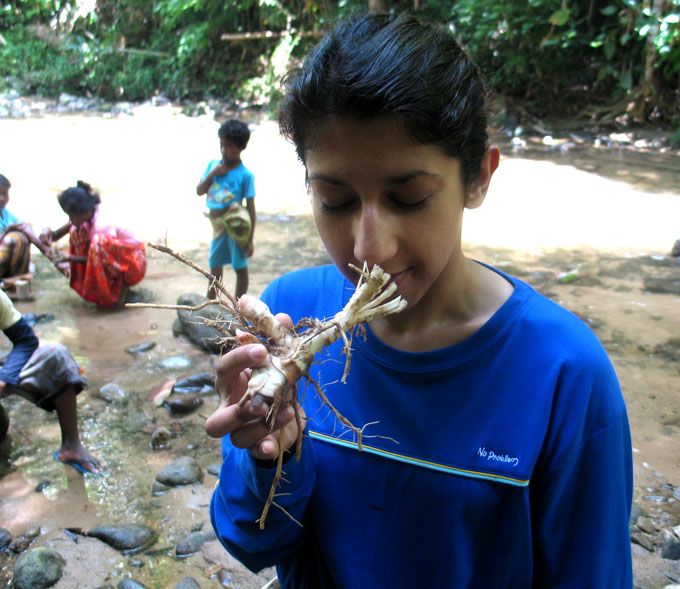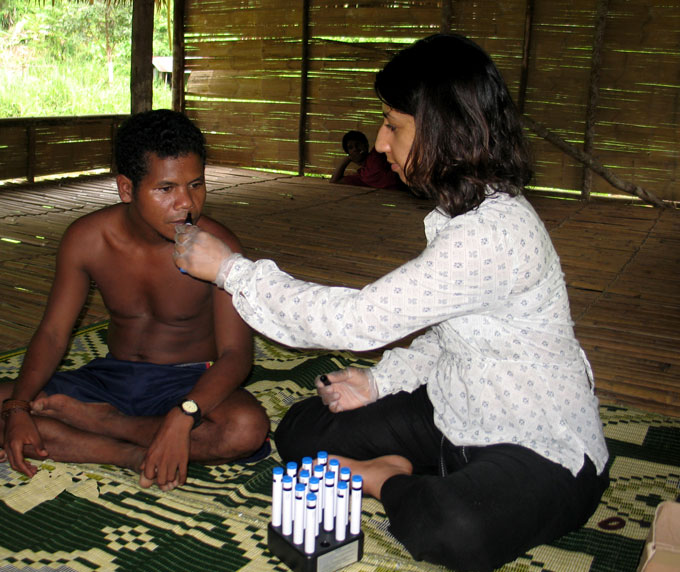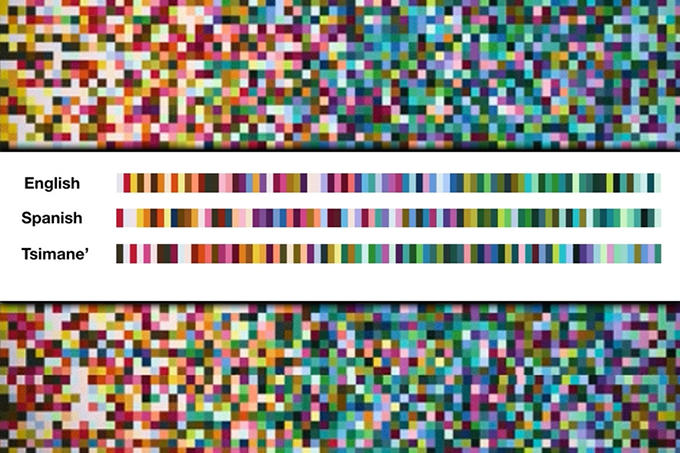What the Color Blue Sound Like What the Blue Color Smells Like
What color is the sky? What about the ocean? Or the grass? These may seem like simple questions with easy answers. The sky is blue. So is the ocean. Grass is green. Bananas are yellow.
If you speak English, this is all very obvious. But what if you speak a different language? Your answers to these kinds of questions may change in surprising ways — and not just because the words you use sound different.
In Kyrgyzstan, a country in Central Asia, a traditional song opens with a line about mountains touching the blue sky. The Kyrgyz word kok (pronounced like cook) means blue. Yet people also walk through kok grass. "We use kok for green color," says Albina Ibraimova, a former English teacher in Bishkek, Kyrgyzstan. Kyrgyz has another word for green, but it's not as common.
Like many Kyrgyz people, Ibraimova also speaks Russian. In Russian, the sky is goluboy (GOL-uh-boy). That means "blue." However, Russians would not call the ocean goluboy. That color is siniy (SEE-nee). Goluboy and siniy are usually translated as light blue and dark blue. But to a Russian speaker they are as different as pink and red are to someone who speaks English.
All people share the same type of brain with senses that work the same way. The human eye contains light-detecting cells called rods and cones. Three different types of cones capture a vast rainbow of around 1 million different hues. In rare cases, a person may have fewer types of cones than usual. That causes color-blindness. There are also reports of an even rarer condition that adds a fourth type of cone. These people may see many more colors than the rest of us.
Unless you have one of these rare conditions, it doesn't matter if you speak Kyrgyz, Russian or English. You'll see the same shade of sky. You just might name and categorize that color differently than someone who speaks another language. You may similarly name and categorize smells, sounds, directions, family relationships and other experiences differently. Why? And what's going on in the brain when it encounters familiar or unfamiliar categories? Researchers who study languages, psychology and the brain are on the case.
Filling in the rainbow
If you look through a box of 64 crayons, you'll find creative names for all the colors. House paints come in hundreds of hues. But most of them belong to just a few color categories. In English, those basic categories include red, blue and so on. All English speakers understand basic color words. They use them for a wide range of shades. A color term like "scarlet" is not basic because it's part of the red category.
In 1969, two scholars found that languages with few basic color words tend to gradually add more over time. And this happens in roughly the same order. If a language has only two basic color categories, they are dark and light. Next comes red, then green and yellow, then blue. The other terms — brown, gray, pink, purple and orange — arrive later. These scholars thought all languages would eventually reach one set of universal basic colors.
And some languages did follow this trend. Ancient Greek had very few color categories while modern Greek has many. Most aboriginal Australian languages also have added new basic color categories over time. But some have lost color categories.
Researchers have found other exceptions. The Berinmo people on the island nation of Papua New Guinea, in the southwestern Pacific, have one word for blue, green and dark colors. But they have two separate words — nol and wor — for shades that English speakers would group together as yellow. Languages that don't have a separate word for blue often group green and blue together in one category, which linguists call grue. The Kyrgyz word kok is one example. Also, languages can add more basic color categories, if needed. In 2015, researchers found that British English speakers are using lilac and turquoise as basic colors.
Perhaps there is a better way to understand color language. In 2017, Bevil Conway and Edward Gibson measured how easy it is for people to communicate colors. Easy color communication, they say, means that when someone says a color name to you, you're both likely to imagine a very similar shade. Conway is a neuroscientist at the National Institutes of Health in Bethesda, Md. Gibson is a cognitive scientist at the Massachusetts Institute of Technology in Cambridge.
These scientists discovered something fascinating. "All languages have the same basic structure," says Gibson. "Warm colors are easier to communicate and cool colors are harder." It didn't matter if a language had two color categories or 10. Names of warm colors, such as pink, red, orange and yellow, tend to cover fewer shades in the color spectrum. People also tend to agree more on which shades should get these names.
Why? Conway thinks the answer has to do with why people name colors in the first place. Think about bananas. "Bananas aren't yellow," he says. They start out green. The peel eventually turns yellow, but the fruit is white. When they go bad, they turn brown and black. Yellow, he says with excitement, "is the color of bananas that you care about." People name colors, he says, in order to categorize things that are meaningful to them. And people tend to care most about things that they can touch and interact with. That's why warmer colors get a larger number of categories.
Don't objects come in all different colors? It turns out that they really don't. The team analyzed colored pixels of objects and backgrounds in 20,000 photographs of natural and artificial objects. The objects tended to be warm-colored. Backgrounds tended to be cool-colored. Blue animals, fruits and flowers are especially rare. "There's lots of blue in the world," says Conway. "But you [often] can't touch it. The sky can't be grasped."
In industrialized cultures, we have dyes that can turn things blue or purple. "We have more and more vivid colors, especially in clothing," notes Galina Paramei. She's a psychologist at Liverpool Hope University in England. When things we care about can come in any color, then we may invent more color terms to tell those things apart. This is just one theory, though.
Asifa Majid, for instance, was part of a team that looked for a relationship between access to colored dyes and color language. And it didn't find one, notes this psychologist at the University of York, in England.

Often, if a language has very few basic color words, then most people who speak that language follow a traditional lifestyle. That may include farming or hunting and gathering. Natural objects tend not to come in many different colors, so naming objects' colors may be unimportant. Gibson has spent time with the Tsimane' (Chi-MAH-nay) people, who live in the Amazon rainforest in Bolivia. "They all know black, white and red," he says. They have some words for other colors, but they tend not to agree on what they mean. "They just don't talk about the other colors," says Gibson. For instance, he notes, "What color is the sky?" That's a question they would never ask each other.
The hidden world of smell

If it seems odd to have no word for the color of the sky, here's a question for you: What does soap smell like?
You may say something like "soapy" or "clean-smelling." If you're sniffing a specific soap, you may say that it "smells like vanilla" or "reminds me of the soap at my grandmother's house." The nose can detect an astonishing 1 trillion different odors. That's way more scents than there are colors! Yet English-speakers rarely talk about them. And when we do, we describe them in very roundabout ways. Most of us are also bad at identifying common scents, such as chocolate or peanut butter.
For a long time, Western researchers thought the lack of categories for smells was biological. Perhaps the nose wasn't as important as the eyes. Or maybe odor-recognizing parts of the brain couldn't link to the language parts. Many scholars have claimed that "it's impossible to have [a] vocabulary for smells," says Majid.
Then she conducted a survey of how people who speak different languages talk about the senses. Her colleague worked with the Jahai. It's a group of hunter-gatherers who live in the Southeast Asian nation of Malaysia. "I brought a smell kit to the field," says this Niclas Burenhult. He's a linguistics researcher at Lund University in Sweden. It was a simple scratch-and-sniff test. Doctors sometimes use these to tell if someone has lost their sense of smell. Jahai volunteers named all the different scents, one by one.
When Majid and Burenhult looked at the results, they were astonished. "The Jahai have got smell language," Majid realized.
The pair reported in 2014 that the Jahai have at least 12 abstract words for categories of smells. To the Jahai, soap smells harim (Ha-RRUM). So do some types of flowers and perfumes. Gasoline, smoke and bat poop all smell like "chnges" (Chung-ES). Roasted food smells chrngir (Chung-EARR). Many other cooked foods and sweets smell chngus (Chung-US). There's even a word for bloody scents that attract tigers, pl-eng (Pull-EG-ng). Burenhult speaks the Jahai language. He says "they group smells like we group colors." This makes scents much easier for them to discuss.
Majid and Burenhult decided to test how people with and without a robust smell language might name the same odors. So Majid ordered vials of 37 different smelly molecules. None of these scents came from specific objects in the world. They were all manufactured. Majid added some of each to the felt tip inside different markers. This is the same process used to make chocolate- or strawberry-smelling colored markers. Only these markers weren't for drawing. And some of them smelled quite disgusting. "The fishy one was probably the worst," recalls Majid. "It was rank. Awful!"
Groups of 30 Jahai speakers and 30 Dutch speakers sniffed each scent, then described it. Like English speakers, the Dutch have very few abstract words for smells. The Jahai speakers took an average of two seconds to name each smell and used just 22 different names in their responses. The Dutch speakers provided a whopping 707 different names and their responses took an average of 13 seconds each.

However, both groups made very similar expressions when sniffing the same scent. There was nothing wrong with the Dutch speakers' noses. They just didn't have categories they could use to describe what they had smelled to others. The team reported its results in 2018.
The lack of smell words in English, Dutch and most other Western languages may not seem like a problem. But it could lead us to overlook one of our very important senses. During the COVID-19 pandemic, many people lost their sense of smell. Some had never before realized just how important smell is, says Majid — especially when it comes to enjoying food.
Why do some cultures develop a dedicated smell or color vocabulary while others don't? "We don't know," says Burenhult. Most likely, he says, there are multiple reasons. The environment, genetics and cultural or religious practices may all play a role.
Developing an ear for language
Learning to speak any language requires the brain to process yet another very important set of categories: sounds. Unless we are using sign language, sound is the way words leave our mouths and arrive in our ears. Not all languages use the same set of sounds. Do you know how to say the word for dog in Spanish? It's perro. You have to roll the "r" sound. It sounds like the rumble of a cat's purr. That sound doesn't exist in English. Similarly, English has a sound, "l" as in lip, that does not exist in Japanese. There are 44 different sounds in English, but a whopping 800 distinct sounds in all the world's languages.
Our brains don't respond to all of these sounds equally. "We're very good at being able to hear the sounds in the languages we speak," says Nina Kraus. She is a neuroscientist at Northwestern University in Evanston, Ill.
For one experiment, she and her team recruited native English speakers and native French speakers to listen to speech sounds. As these people listened, the researchers recorded their brainwaves. One of the speech sounds — they — exists in English but not in French. The other — which sort of sounds like ru — exists in French but not English. The participants' brains became more active when they heard the sound that existed in their native language.
If the researchers had been testing newborn babies, they wouldn't have seen this difference. A newborn has no way of knowing what language it will have to learn. In the 1970s, researchers discovered that an infant's brain pays equal attention to all language sounds. "The baby can hear all the nuances of every sound of every language in the world," explains Kraus.
Over the first few months of your life, your brain will change. It learns to pay special attention to sounds common in your native tongue. By the time you're walking and talking, your brain is no longer paying attention to unfamiliar language sounds. In a sense, says Kraus, "you're deaf to these sounds." As a result, a Japanese speaker may mix up the English words lip and rip. Similarly, an English speaker may have trouble hearing any difference between the two Hindi letters, "ड" (dah) and "ढ" (dha), because English has just one dah sound.

Anyone can learn to speak any language. That means anyone can learn new categories for smells or colors or sounds, just as Burenhult learned the Jahai smell vocabulary. "If I had to choose a superpower, it would be to have the ability to speak any language," Kraus wrote in her 2021 book, Of Sound Mind. A person's language is that person's sense of home and belonging, she explains. Sharing a language means sharing a way of categorizing and making sense of the world.
Learning or studying new languages "opens up a world of possibility," adds Majid. "We think the world is one way," she says, but maybe it's only that way because that's how we tend to talk about it. Other cultures could be talking about things totally differently. Instead of using words for left and right, some cultures use only north, south, east, and west. So someone might say, "your east shoe is untied." Other cultures use one word for both older sister and aunt, and another word for both younger sister and niece.
So is the sky blue? The answer depends on what "blue" means to you — in your culture and in your language.
Source: https://www.sciencenewsforstudents.org/article/color-smells-sounds-language




0 Response to "What the Color Blue Sound Like What the Blue Color Smells Like"
إرسال تعليق